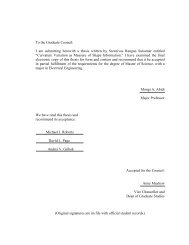To the Graduate Council: I am submitting herewith a dissertation ...
To the Graduate Council: I am submitting herewith a dissertation ...
To the Graduate Council: I am submitting herewith a dissertation ...
- No tags were found...
You also want an ePaper? Increase the reach of your titles
YUMPU automatically turns print PDFs into web optimized ePapers that Google loves.
Chapter 1: Introduction 4<strong>To</strong> achieve our goals we started by devising a robust feature descriptor for generalunorganized and noisy point-sets. Several local and global descriptors were proposedfor surface-based registration, using mostly differential properties. Given that we workwith <strong>the</strong> most general case of point-sets we will employ a recently developed andpowerful tool for feature inference n<strong>am</strong>ely tensor voting. The philosophical reasonbehind this choice, as well as behind <strong>the</strong> choice of <strong>the</strong> point-sets representation, is thatcurrent 3D digitization devices actually provide point-sets s<strong>am</strong>pled from <strong>the</strong> surfaces.Surface topology and differential properties are currently just inferred from <strong>the</strong>ses<strong>am</strong>ples. In <strong>the</strong> registration task <strong>the</strong> goal is precisely to reconstruct <strong>the</strong>se surfaces from<strong>the</strong> combination of several datasets. The redundancy of information will allow for <strong>the</strong>accurate recovery of shapes. Hence it is more suitable, when possible, to register <strong>the</strong>raw point-sets without any processing so that we don’t loose irrecoverable shapeinformation. The efficient Tensor Voting fr<strong>am</strong>ework [Medioni00] will help us indesigning a local feature descriptor which will measure <strong>the</strong> visual importance of points,also known as saliency. This descriptor will prove robust to noise and information rich.It will allow <strong>the</strong> implicit embedding of salient feature information and confidence in aconvenient format suitable for our registration algorithm. It will also have <strong>the</strong> advantageof being computationally efficient.Having a good local descriptor such as our point saliency measure will helpsignificantly with <strong>the</strong> correspondence task, which is <strong>the</strong> main challenge for registration.In <strong>the</strong> work that will be described in this <strong>dissertation</strong> we depart from <strong>the</strong> ICP criterionand designing a new energy function that quantifies registration. In this we are guidedby <strong>the</strong> limitations of ICP methods. Our development starts with a simple combinatorialmatching criterion that is consistent with a rigorous definition of <strong>the</strong> registration task. Acontinuously differentiable energy function is obtained from this criterion by <strong>the</strong>method known as mollification, which is simply a smoothing by convolution with aGaussian kernel. We will interpret this criterion physically in terms of Gaussian forcefields that are exerted by one of <strong>the</strong> point-sets on <strong>the</strong> o<strong>the</strong>r. The strength of this field
















